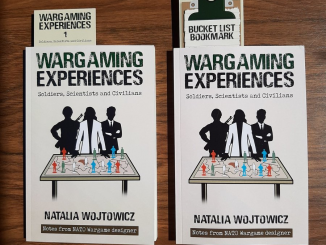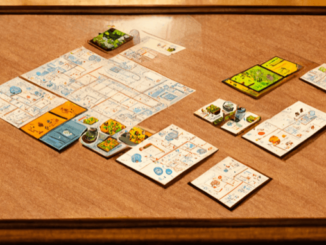
Wargaming is a rather interesting sector within the world of games, primarily due to its widespread use as both a recreational activity played amongst friends and peers or as a professional tool to be used to train tactical thinking and decision making within military personal looking to take on a commanding role. This makes it a very flexible format of games that fulfil different requirements that the clients wish the games to accomplish, professional or otherwise.
Now it’s all well and good to sing the praises of these games but we need to first understand what Wargaming is all about before we dive into who uses them and why they’re popular with different audiences.
What is Wargaming and where did it come from?
One of the simplest descriptions of Wargames comes from Decision Games; which says “a wargame is a model of a military situation which players can control” (Decision Games, 2020). Expanding on this further, it has the players of the game take on a commanding role within a military scenario and has to plan their strategies and make decisions based on their current circumstances within the given scenario in order to achieve victory against their opponent.
Humans have been playing games that simulate the idea of military strategy with game pieces representing their forces for a very long time, with games such as Go and Chess being usually the first games that spring to mind when someone typically thinks about strategy games.
However, according to the Historical Miniatures Gaming Society (HMGS), we know that most of the Wargames that would see use within a military setting evolved from these aforementioned games. The first attempt of a militarised Wargame being introduced in 1811 by the Prussian Baron von Reisswitz which used a table set to a specific scale, filled with sculpting sand, modular tiles, rulers and dividers to regulate movement and porcelain unit blocks.


Although it was well received by the Prussian and Russian aristocracy, Peterson(2012) highlights that military officers didn’t adopt it as a strategic tool due to the original version of the game presented to the royal family was far too expensive to reproduce commercially and due to the Baron being preoccupied with the ongoing Napoleonic wars, the rules and mechanics of the game weren’t refined to function in a reliable manner that best represented the situations that could be found within military skirmishes.
Further Developments in Wargaming
This was up until 1824 where his son George Heinrich Rudolf Johan von Reisswitz took it upon himself to develop the game further into a more reliable and structured game that would better simulate the experience of leading an army.
He would reintroduce this game as Anleitung zur Darstelling militarische manuver mit dem apparat des Kriegsspiels (Instructions for the Representation of Tactical Maneuvers under the Guise of a Wargame). Along with this new name, there were some major changes that would help to improve the structure of the game as well as better quantify the circumstances that may occur during military skirmishes.
These changes included; the introduction of game pieces that represented units of troops which could take a set amount of damage, their actions are represented by dice rolls and can’t be moved by the players themselves, Topologic maps that featured real locations and more natural terrain and finally the introduction of an umpire, an impartial and experienced military officer who interprets and carries out the orders of the players by carrying out the dice rolls and managing the positions of the players troops. (Von Reisswitz, 1824)
After introducing this revised version of his father’s game to the King and Generals, it was very well received, especially from General Von Müffling who declared “this is no ordinary sort of game, this is schooling for war. I must and will recommend It most warmly to the army”. As a result, the king ordered this game to be mass produced and distributed to every regiment in the army. (2012)
This fun little relic of a game is still being used today, thanks to the translation work of Bill Leeson, so definitely look into him if you’re interested in how this game is being used today.
Kriegspiel – translated by Bill Leeson is available from Amazon
Why is it used by the military?
Now that the history lesson is out of the way, there are many reasons that military personnel would make use of wargames in the midst of training. Here are just a few that spring to mind;
- By far the most obvious and important reasons to utilise Wargames during military training would be that they are cheap to purchase or develop when compared to purchasing the necessary training equipment and hiring training staff to carry out in person training exercises.
- Depending on the game, sessions can be very time efficient, especially when you need to restart or create a new scenario. This allows for more time for training when compared to having to restart a live action training session where you have to manage multiple people and reset or replace pieces of equipment after each session which can be time consuming and more difficult to manage than pieces of a game (much less irritative too which is a plus).
- Having the capability to be easily customise the scenarios that are presented to your players is a boon, especially if you want to test how someone handles situations within certain parameters (Having multiple players serving as allies or enemies, having fewer resources or troops than usual, introducing a time limit, etc.).
- Having a specified set of rules and objectives that the players have to follow makes it easy for supervisors and trainers to keep track of any analytics based on their performance and choices as they play, especially when combined with the customisable parameters from the previous point.
- Finally, conducting training through the use of Wargames offers a safe and controlled environment where mistakes can be made without fear of injury of anyone involved. (This is especially true when it compares to the risks posed to trainees during live fire exercises)
What’s the civilian appeal?
Although most Wargames are made with the intent of being used to assist with training military personnel, there is a huge market within the civilian market for these types of games. Being a professional civilian and having grown up playing a wide array of games, I can definitely think of some reasons for why these games would be appealing to the average joe.
Firstly, depending on the game’s historical setting, they can offer the players the opportunity to learn more about the history behind the events that are being represented within the game. This leads to the next point which is these games allow the opportunity to roleplay as a commanding officer within the game world, especially if the setting is a favourite of the players. Another reason could be that the players enjoy the intellectual stimulation that these games can offer. The last appealing aspect of these games is the chance to engage in some friendly competition with friends and family, especially if the setting is a one that the players are familiar with.
How can businesses benefit from these games?
If utilised correctly, Wargaming could be beneficial to be used with the training of teams within the business world. Aside from points that are fairly similar to why these games are popular with the civilian audience (Teambuilding exercises, friendly competition etc.), the main thing that must be considered when utilising these games would be the type of training you wish to support and choosing the right type of games to support that kind of experience you wish to provide to your employees.
The diagram below does show that Wargaming does support the training of decision-making skills, it is important to note that there are many different forms of decision making skills, with the main split being between improving the ability to make more informed decisions based on the knowledge and education of your workforce or improving the capacity to make choices based on analysed data gathered through research.

Although it is rather complicated at a glance, this diagram is just a quick glimpse into the potential training possibilities that can be offered to businesses if they implement them in a sensible way that benefits their work force.
To wrap everything up, Wargaming is a very unique beast within the gaming world that is enjoyed for reasons that change depending on the audience that plays them, be it a tool for training the commanding skills of military personnel, a potential means of testing and training the decision making capabilities of the workforce of commercial businesses, or as an intellectually entertaining way to kill some time with friends and family.
For lack of a better phrase, there’s something here for everyone!
References and further reading
Decision Games (2020) What Is Wargaming? – Decision Games. Available at: https://decisiongames.com/wpsite/dg-history/what-is-wargaming/ (Accessed: 26 September 2020).
LBS, Longley Brown, G. and Curry, J. (2017) What is Wargaming? | LBS. Available at: http://lbsconsultancy.co.uk/our-approach/what-is-it/ (Accessed: 28 September 2020).
Leeson, B. (2018) Von Reisswitz’s Original Equipment – Kriegsspiel, Kriegsspielorg. Available at: https://kriegsspielorg.wordpress.com/articles-2/von-reisswitzs-original-equipment/ (Accessed: 27 September 2020).
Peterson, J. (2012) Playing at the World: A History of Simulating Wars, People and Fantastic … – Jon Peterson – Google Books, Unreason Press. Available at: https://books.google.co.uk/books?id=syNzMAEACAAJ&dq=isbn:9780615642048&hl=en&sa=X&ved=2ahUKEwj0oO-cjInsAhXWi1wKHe0qBesQ6AEwAHoECAAQAg (Accessed: 27 September 2020).
Von Reisswitz, G. (1824) B. Von Reisswitz – 1824 Wargames Rules of the Prussian Army | Artillery Battery | Battalion, Scribd. Available at: https://www.scribd.com/document/201901872/B-Von-Reisswitz-1824-Wargames-Rules-of-the-Prussian-Army (Accessed: 27 September 2020).
- Observing how games teach players to think and plan ahead - 12th March 2021
- Learning about systems using games. - 15th January 2021
- Focus on… Wargaming and Wargames - 8th November 2020




Be the first to comment